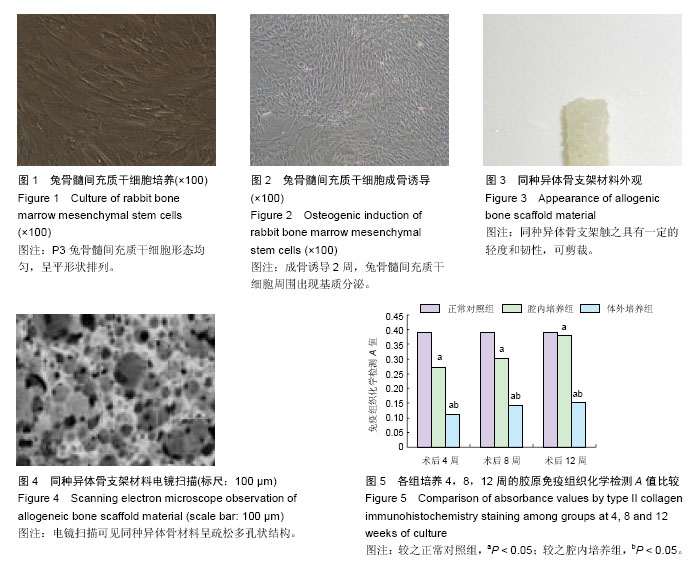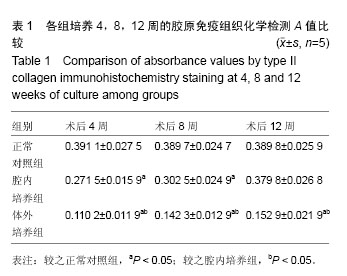| [1] 肖丰伟.骨髓间充质干细胞联合异体骨治疗骨缺损的实验研究[D].泰山医学院,2010. [2] 王斌,吕浩然,王伟雄,等.异体皮质人工骨复合物治疗骨折不愈合及骨缺损[J].中国组织工程研究,2013,17(51): 8821-8826.[3] Han Y,Lan N,Pang C, et al.Bone marrow-derived mesenchymal stem cells enhance cryopreserved trachea allograft epithelium regeneration and vascular endothelial growth factor expression. Transplantation: Official Journal of the Transplantation Society. 2011, 92(6):620-626.[4] Lee JY,Choi MH,Shin EY, et al. Autologous mesenchymal stem cells loaded in Gelfoam for structural bone allograft healing in rabbits. Cell Tissue Bank. 2011;12(4):299-309.[5] Dong JL, Li LX, Mu WD, et al. Bone Regeneration with BMP-2 Gene-modified Mesenchymal Stem Cells Seeded on Nano-hydroxyapatite/Collagen/ Poly(L-Lactic Acid) Scaffolds.J Bioact Compat Polymer. 2010;25(6):547-566.[6] 朱肖奇,贺用礼,马雪峰,等.生物衍生骨与骨髓间充质干细胞复合修复免桡骨大段缺损[J].中国组织工程研究与临床康复,2009,13(3):417-422.[7] Tran CT,Gargiulo C,Thao HD, et al.Culture and differentiation of osteoblasts on coral scaffold from human bone marrow mesenchymal stem cells. Cell Tissue Bank.2011;12(4):247-261.[8] Reinders ME, de Fijter JW, Roelofs H, et al. Autologous bone marrow-derived mesenchymal stromal cells for the treatment of allograft rejection after renal transplantation:Results of a phase I study. Stem Cells Trans Med. 2013;2(2):107-111.[9] 江标,李明.骨组织工程中骨髓间充质干细胞与细胞因子的研究进展[J].重庆医学,2006,35(24):2290-2293.[10] 黄相杰,姜红江,孟鹏,等.自体间充质干细胞移植异体韧带重建治疗膝交叉韧带损伤[J].中国实用医药,2011,6(36): 92-95.[11] Itakura S,Asari S,Rawson J, et al.Mesenchymal stem cells facilitate the induction of mixed hematopoietic chimerism and islet allograft tolerance without GVHD in the rat. Am J Trans. 2007;7(2):336-346.[12] Tang TT, Lu H, Dai KR, et al.Osteogenesis of freeze-dried cancellous bone allograft loaded with autologous marrow-derived mesenchymal cells. Mat Sci Eng. 2002;20(1/2):57-61.[13] 刘彩云.骨髓间充质干细胞联合异体骨治疗蒙古羊胫骨缺损的实验研究[D].内蒙古农业大学,2014.[14] 刘阳.富集骨髓间充质干细胞复合nHA/CS材料修复兔骨缺损的实验研究[D].南方医科大学,2011.[15] 王宏彬.同种异体骨髓间充质干细胞的研究现状[J].中国组织工程研究,2012,16(23):4306-4309.[16] 杨楠,何惠宇,胡杨,等.复合骨髓间充质干细胞同种异体支架骨修复羊髂骨极限缺损[J].中国组织工程研究,2013, 17(16):2859-2868.[17] 刘晓阳,李广润,刘洪涛,等.硫酸钙人工骨/骨髓间充质干细胞构建组织工程化骨诱导脊柱融合[J].中国组织工程研究,2014,18(21):3281-3286.[18] Zhang Q, Yang H, Wei YG, et al. Selection of Destination Ports of Inland-Port-Transferring RHCTS Based on Sea-Rail Combined Container Transportation.// Innovation and sustainability of modern railway: Third international symposium on Innovation and sustainability of modern railway (ISMR 2012), September 20-21, 2012, Nanchang, China, 2012:675-680.[19] Khojasteh A, Eslaminejad MB, Nazarian H, et al. Vertical bone augmentation with simultaneous implant placement using particulate mineralized bone and mesenchymal stem cells: a preliminary study in rabbit. J Oral Implantol. 2013;39(1):3-13.[20] Wei X,Mao Z,Hou Y, et al. Local administration of TGFbeta-1/VEGF165 gene-transduced bone mesenchymal stem cells for Achilles allograft replacement of the anterior cruciate ligament in rabbits. Biochem Biophys Res Comm. 2011;406(2):204-210.[21] 谭新颖.同种异体骨髓间充质干细胞复合同种异体冻干骨修复比格犬半侧下颌骨缺损的实验研究[D].中国人民解放军医学院,2014.[22] 邢志远,张继波,孔令菊,等.深低温冻存羟基磷灰石/骨髓间充质干细胞修复兔桡骨缺损[J].中国组织工程研究, 2013,17(25):4629-4636.[23] 刘昌奎,谭新颖,徐娟,等.骨髓间充质干细胞复合同种异体骨支架体内构建组织工程骨修复髁突缺损的实验研究[C].//2013年全国第五届口腔颌面外科修复重建学术会议暨国际研讨会论文集.2013:54-55.[24] Vulcano E, Murena L, Falvo DA, et al. Bone marrow aspirate and bone allograft to treat acetabular bone defects in revision total hip arthroplasty: Preliminary report. Eur Rev Med Pharmacol Sci. 2013;17(16): 2240-2249.[25] Kuo YR,Chen CC,Shih HS, et al.Prolongation of composite tissue allotransplant survival by treatment with bone marrow mesenchymal stem cells is correlated with T-cell regulation in a Swine hind-limb model. Plastic Reconstruct Surg. 2011;127(2):569- 579.[26] Nather A,David V,Teng JW, et al.Effect of autologous mesenchymal stem cells on biological healing of allografts in critical-sized tibial defects simulated in adult rabbits. Ann Acad Med. 2010;39(8):599-606.[27] 刘昌奎,谭新颖,徐娟,等.骨髓间充质干细胞复合同种异体骨支架体内构建组织工程骨修复髁突缺损的实验研究[C].//第五届全国口腔颅颌面修复重建外科学术会议暨国际研讨会论文集.2013:54-55.[28] 李涛,宋国栋,包崇云,等.骨髓间充质干细胞作为干细胞参与生物材料异位诱导成骨[J].中国组织工程研究与临床康复,2010,14(21):3819-3822.[29] 费志强.BMP-2基因修饰的骨髓间充质干细胞复合PLLA/n-HA人工骨修复大鼠股骨缺损的实验研究[D].中山大学,2013.[30] 李光辉.外周血CD34+细胞与骨髓间充质干细胞共培养修复兔颅骨缺损的实验研究[D].第四军医大学,2013.[31] 王小志.基因转染骨髓间充质干细胞复合同种异体骨修复羊髂骨极限缺损[D].新疆医科大学,2014.[32] Hara Y,Stolk M,Ringe J,et al.In vivo effect of bone marrow-derived mesenchymal stem cells in a rat kidney transplantation model with prolonged cold ischemia. Transpl Int. 2011;24(11):1112-1123.[33] Aksu AE,Horibe E,Sacks J,et al.Co-infusion of donor bone marrow with host mesenchymal stem cells treats GVHD and promotes vascularized skin allograft survival in rats. Clin Immunol. 2008;127(3):348-358.[34] 钱三祥.兔同种异体脱钙骨复合骨髓间充质干细胞体外培养的成软骨观察[D].安徽医科大学,2011.[35] 王小志,何惠宇,杨楠,等.基因转染骨髓间充质干细胞复合同种异体骨修复绵羊极限骨缺损[J].中国组织工程研究, 2013,17(47):8141-8148.[36] 刘杰,许建中,王序全,等.脱钙骨基质支架构建组织工程骨的实验研究[J].第三军医大学学报,2005,27(9):888-891.[37] 景彩霞,刘昌奎,谭新颖,等.骨髓间充质干细胞与同种异体骨复合修复犬下颌骨缺损:成骨能力检测[J].中国组织工程研究,2015,19(14):2138-2143.[38] 王刚,刘一,单玉兴,等.不同应力环境对兔骨髓间充质干细胞修复关节软骨缺损的影响[J].中国修复重建外科杂志, 2004,18(2):96-99[39] Smith RL,Lin J,Trindade MC,et al.Time-dependent effects of intermittent hydrostatic pressure on articular chondrocyte type II collagen and aggrecan mRNA expression.J Rehabil Res Dev.2000;37:153-161.[40] 赵子义,杨雷,徐鹏,等.同种异体骨髓间充质干细胞关节腔内成软骨分化的实验研究[J].中华外科杂志,2005,43(20): 1340-1343.[41] 徐斌,宣涛,徐洪港,等.骨髓间充质干细胞与同种异体脱钙骨基质组合生长因子诱导向软骨细胞分化[J].中国组织工程研究与临床康复,2011,15(21):3822-3828. |
.jpg)


.jpg)